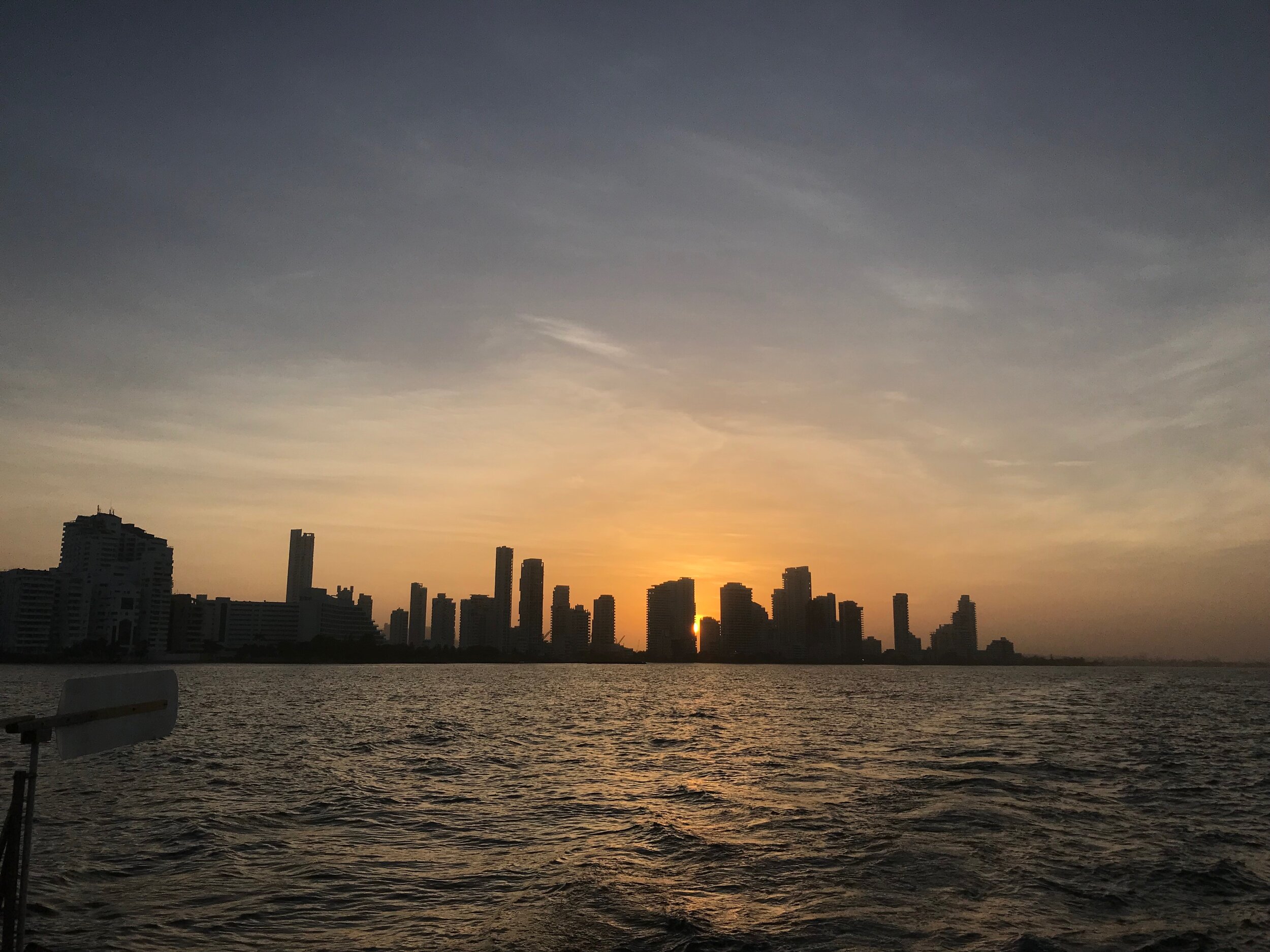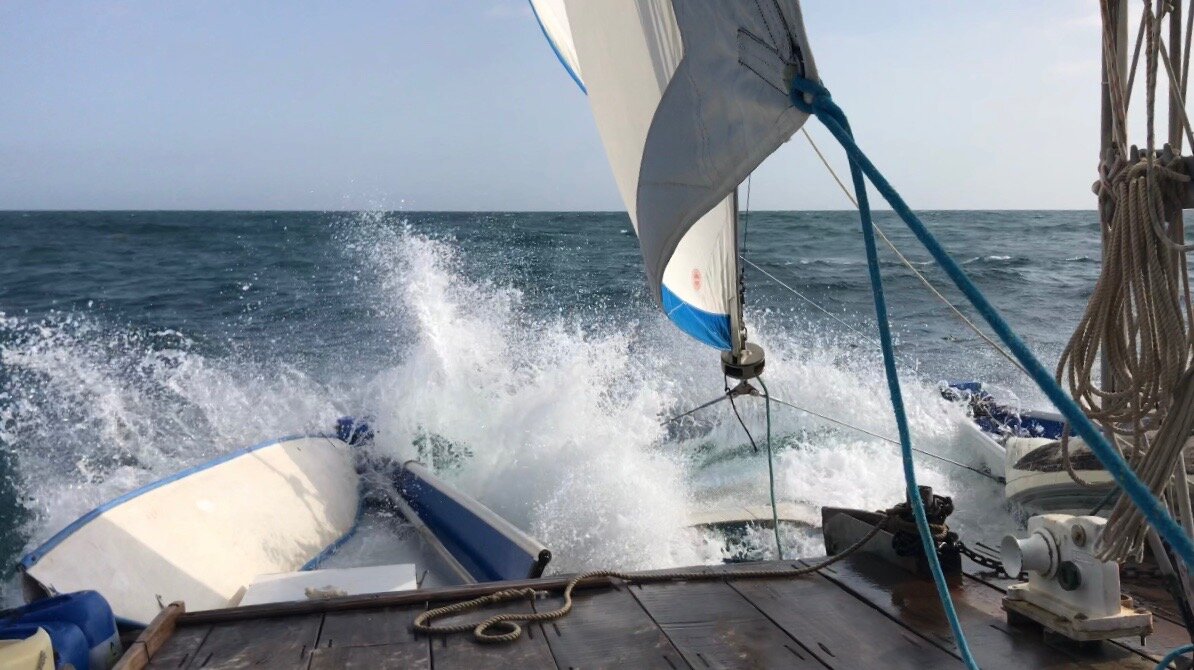As real as it gets...
At dawn, over a week after arriving in the bay of Cartagena, it was finally time to leave again. I woke up around 5am, and in the dark, still half asleep, I began prepping the boat for departure. Hans rowed over from Ontong Java to help me pull up the anchor, which came up easily, and then he gave me a quick kiss before hoping back in the dinghy and rowing back to his boat. I put my engine in forward and began steaming out of the anchorage. After clearing all of the boats, but not yet the statue of the Virgin Mary which sits in the channel, the engine coughed to a halt. I hopped down into the engine hold and pulled and pulled at the rope start. Although I knew I wasn’t in any immediate danger due to an almost non-existent current, I was still extremely relieved once the engine roared back to life and I was able to get some forward drive away from the statue. I brought up my mainsail while still inside the calm of the port even though the sea breeze had not yet started. By the time we reached the breakwaters leading out in to the Caribbean Sea, the sun was just peeking behind the skyscrapers of Cartagena. “Here we go…” I thought to myself.
I kept my engine in forward at 3 knots for two more hours. Though it struggled, the day’s breeze made an effort to show itself during that time. By 9am it became steady enough that I could cut the engine and pull out my foresails. As the day progressed, the wind got stronger. I had been aboard Mara Noka as sole captain for about a month at this point; through each of the days spent sailing in the previous weeks, the experience and knowledge I gained had been invaluable. However, I was not yet very confident in my sailing abilities, so the increasing wind-speeds still put me on edge.
I spent most of my time lying in bed praying nothing too crazy would happen, eating soda crackers and fruit, and the occasional spoonful of Nutella. Every hour or so it was time to make a tack, as we were still trying to get farther east before bearing north towards Hispaniola. By the end of the day, my hands were sore from pulling on the lines at each tack, my belly empty from lack of any real food, and my body exhausted from the sun and wind of a late Caribbean spring.
“Muesli, muesli, do you copy?” I called to Ontong Java over the radio. “This is Muesli, over.” I had seen a nice bay coming up in less than ten miles, and I figured it would be a nice place to rest for the evening. I definitely needed it. “My chart does not show any bay for another 15 miles, so that’s where we’ll go,” Hans’s voice came over the radio speaker as if he was right next to me. I checked the electronic chart on my phone, which I figured was up to date, and saw no other protected area after the bay coming up and until Barranquilla. “I don’t know what you see, but there’s nowhere else to stop,” I pleaded. “Well if you’re so sure, then you stop. I’m carrying on,” he said in his overpowering tone of voice. “I will,” I came back.
It took a few more hours before we were close enough to the bay I had seen on the chart to be able to see it with the binoculars. I saw marker buoys. This had to be it. As if reading my mind, Hans hailed me again on the radio, “We’re stopping here for tonight.” No mention about how I had been right, so I let the ‘I told you so’ burning on my tongue fizzle out. By dusk we were anchored in a well protected bay, behind a sandbar. I paddled over to Ontong Java for supper, and to have a look at his chart for this other anchorage he swore existed. When I arrived and took the yellowing paper into my hands, I noticed the coastline between where we were and Barranquilla was completely different than what I had on my electronic chart. Where we were anchored now did not exist on that paper, and sure enough some 5 miles ahead there promised to be some protection. But there wasn’t, because the chart was dated 1975 and the strong current flowing from the Rio Magdalena had certainly been shifting the ground constantly over the past 30 years. The sandbank we were now sitting behind could very well only be a couple of years old, and who knows how many more years it would last. Regardless, I was happy to be in flat water again, to have a nice shower, and to rub my raw hands with lotion.
As quickly as the sun set, the next day it rose, and so did our anchors. The morning was calm, with only a slight breeze, but as if being on a strict schedule, the trade winds were howling by 10am—and man was it rough. After a few hours of beating, I could see in the distance that the water changed color in a seemingly straight line. From deep blue to a murky green. “This must be caused by the outflow of the Rio Magdalena,” I thought. As I approached the convergence of the two-toned waters, my suspicions were validated by first some sticks and branches, then eventually full blown logs floating by. Around 2pm, I heard a “cheesecake, cheesecake, do you copy?” call. “Let’s just continue on today, huh?” Hans asked. “To Haiti, you mean?!” I practically screamed over the radio, “no fucking way.” “Toughen up, the wind is perfect,” he said. By then we were far enough up the Colombian coast to feel the beginnings of the ever-present fury of funneling tradewinds. I felt sick to my stomach, but maybe I was just nervous about the prospect of heading out into over 400 miles of open sea for the first time. I mean, after all, what did I know? “We are less that 15 miles from Barranquilla, maybe we should stop for the night and see what the weather is like tomorrow? It’s fucking rough,” I said, in the pleading tone of voice I’d become poorly accustomed to using. Water sprayed viciously over the whole deck every time I hit a wave at an odd angle. There was fear floating in my head and pulsing through my veins, but it was a different fear than I had ever experienced before. It was one of complete uncertainty, yet full of hope, faith, and trust. Almost as if I was sailing on the palms of god itself. I didn’t know what could go wrong, so there was nothing realistic for me to imagine, worry about, or even prepare for. Though the whole time I felt the odd sense of fear, and hoped that nothing would go amiss. Regardless, I still did not want to begin my first real crossing on this note.
After another couple of hours, I tried my luck again. This time Hans agreed that it was excessively rough and we should make a tack into Barranquilla. “YES, thank you,” I rejoiced to myself. Four hours later, again at dusk, I dropped anchor on the outside of the entrance to Rio Magdalena, next to Ontong Java who had arrived first. And there we sat, but not just for the night. A heavy low pressure system was passing through the Caribbean and for the following three days the wind howled at a constant 28 knots, with some gusts making it nearly impossible to walk forward on deck. I was so happy to not be out at sea. Adrenaline and anxiety about the upcoming trip somehow made the days fly by—or maybe the wind did that. Either way, one morning it was calm enough, around 15 knots, and it was time to go. We’d come this far, there wasn’t any other choice besides drifting back to Panama, and there is nothing that scares me more than showing back up somewhere I had made such a drama of leaving. I can barely remember that morning, pulling up anchor, or sail, or what the first waves felt like as I sailed out into the Caribbean Sea. I don’t remember if I was seasick immediately, or if I had made myself any food. It was all just too surreal… or rather, too real. As real as it gets. “Good luck,” I wished myself.


